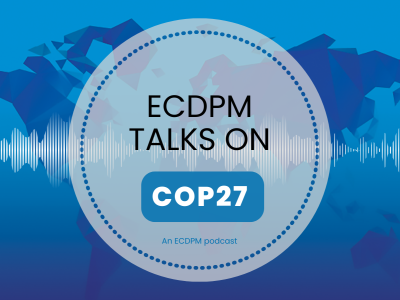
Challenges in 2014: Modernisation of EU development cooperation, kick-started or running on the spot?
+++ ECDPM Challenges blog series. Post number two +++
The European Union’s Agenda for Change is a case of evolution over revolution. The EU’s new development policy sketches an aid-centric reform strategy that introduces significant changes for the European aid and development cooperation landscape in 2014-2020. With Europe in crisis and aid under pressure, the EU wants to increase the effectiveness of its development assistance. What are the biggest implementation challenges, and how fit is the EU to do so?
The year 2014 will close the circle from policy to programming to practice. The EU’s aid budget was kept steady, with the scope of budget lines broadened to address new challenges. Preparations for implementing the Agenda are on the home stretch, with EU institutions currently in the final stages of deciding how much EU aid goes to each partner country, and what will be done with said aid, in National / Multi-annual Indicative Programmes (NIPs / MIPs). The European Commission’s Directorate-General for Development and Cooperation (DEVCO) will start implementing the NIPs / MIPs.
Unsurprisingly, EU institutions need to adapt tools and practices to the Agenda’s new priorities, concentrating notably more on food security and sustainable energy in least-developed and low-income countries. EU Delegations have to rebalance capacities and contacts to effectively work in these sectors, and manage sensitive aid exits.
New challenges require new ways of doing business. Dwindling aid budgets mean the EU needs to prove it can be more than the 29th European donor. The institutions need show leadership in realising increased aid coordination between the EU and its Member States, who remain uncommitted to jointly agree on aid spending. With five aid coordination pilots showing positive results, such ‘joint programming’ will be rolled out in over 40 developing countries in the coming years.
For the EU’s own aid, tools used in a particular country may depend on countries’ governance profile. This evaluation process, as well as the revamped results measuring and reporting tools, will be run through a first test in 2014. The EU is in dire need to better demonstrate results of its aid and assistance. It remains unclear how these will be measured: DEVCO has provided guidance to EU Delegations on defining results and selecting indicators accordingly.
Opportunities to work more with the private sector are also explored, allowing the institutions to leverage over 20 times the aid invested. The above underlines that 2014 is a critical year to overhaul human resources for external action: staff with specific skills and competencies are needed to manage the Agenda for Change’s rollout. They should able to estimate political implications of aid and engage with new actors (notably the private sector) using new tools.
These changes do not occur in a policy vacuum. New policy directions will be proposed in 2014, including on the EU’s role in promoting health in developing countries and more specific post-2015 goals and targets. Will the EU services’ tools, programmes and results framework be flexible enough and have sufficient traction to incorporate and survive policy shifts? With a new global framework for development looming, and a new Commission incoming in November, 2014 will be a year in which EU external action needs to stretch as well as flex its muscles.
With these challenges ahead, how fit is the EU to manage change? Some developments are promising. A new director-general for DEVCO will take office this month. Fernando Frutuoso de Melo, current deputy DG for the EC’s human resources, is a seasoned Commission official. He previously managed sensitive institutional relations, working in the past Commissioners’ cabinets, the EC secretariat and Barroso’s private office. This should equip him to handle DEVCO’s chequered rapport with the European Parliament, as well as other EC Directorates. Having also advised on DEVCO’s organisational issues, he also seems well placed to guide DEVCO through the evolving working arrangements with the EEAS and the HR issues noted above.
Reconstruction is already underway at DEVCO. Following a workload assessment, Delegations in Kenya, Thailand, Nicaragua and Egypt are being upgraded to support and advise budget support activities and thematic expertise of the EU Delegations in their respective regions. DEVCO’s units for quality & results and for evaluations have both increased in profile – now reporting directly to deputy director-generals. This is an encouraging sign that results-based management of EU aid might receive more attention, previously at risk of being side-lined.
Whereas DEVCO is looking to strengthen in-house learning from past experience, it has downgraded investment in political economy analysis tools and practices. With EU aid operating increasingly in connection with other actors, tools and partners under the Agenda for Change, this may leave the EU institutions with little understanding of the game they are playing. EU aid tools also need to complement one-another at national, regional and continental levels.
Ultimately, 2014 will be a test to whether the services can manage necessary changes to realise EU aid ambitions given uncertainty on the future political leadership.
The views expressed here are those of the author, and may not necessarily represent those of ECDPM.

